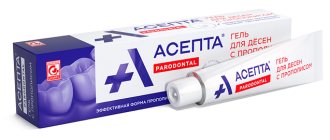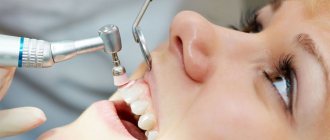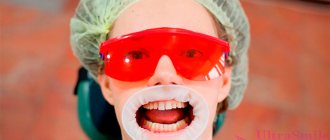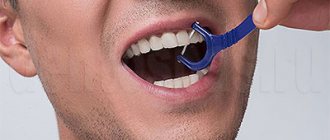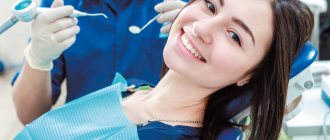Reasons for the development of the gag reflex
The reasons for the appearance of a gag reflex when caring for the oral cavity are:
- Pregnancy. Women often experience unusual reactions during this period. The taste of the paste can cause severe nausea and make you feel unwell.
- Stress. The body in this condition may not respond correctly to irritants, including brushing teeth, using mouthwash, toothpaste or floss.
- Smell. The care products have a sharp, pronounced aroma. These scents are not suitable for everyone, especially for some specific ingredients.
- Taste. This characteristic of cleaning products is also not suitable for everyone. The only option is an individual choice of composition with an optimal, tolerable taste.
- Mechanical impact. Brushes with different types of bristles can irritate the mucous membrane, causing a gag reflex.
- Fluorine. This element provides protection to the enamel, but it is what causes nausea in many people.
Poisoning
The appearance of nausea while brushing your teeth may coincide with food poisoning or intestinal infection, the symptoms of which are:
- loose stools;
- constant nausea;
- high temperature;
- weakness, headache.
Food poisoning
In this case, the area at the root of the tongue will be overly sensitive due to intoxication of the body with microbial substances or low-quality products. If these sensations are influenced by a toothbrush or too harsh toothpaste, then another attack of vomiting may be provoked.
Stages
Nausea when brushing your teeth is usually a defensive reaction that is triggered by an irritant, for example, the strong taste of toothpaste. The mechanism of development is quite simple - when cleaning, discomfort is felt, while the person looks at himself in the mirror. A signal is sent to the brain and a reaction develops in the form of vomiting to eliminate the irritant.
The reflex develops through four stages:
- the condition worsens, irritability, fatigue appear, and there is a urge to vomit;
- nausea develops;
- after vomiting there is relief;
- in the intervals between deteriorations, the person feels normal.
If the problem affects children
Children have their own reasons for nausea from brushing their teeth. This can also be affected by an unsuccessful trip to the dentist, which causes fear and a certain amount of stress during the procedure.
Only the right calm conversation with the baby will help here. You need to explain to your child that brushing your teeth will not hurt. And how necessary it is so that you no longer have to go to the doctor.
At the first stage, you should allow him to brush his teeth as much as he can, and then gradually increase the time. You should not force a child to brush their teeth. Doing it this way will only make the problem worse.
A child can be attracted to the procedure by acting it out. It’s worth coming up with some kind of game: “Who is faster” or “Counting teeth” and others. Over time, the baby will stop being afraid and take the procedure for granted if the parents carry out the process with him.
Colgate range of toothpastes for adults and children.
In this article, we will find out together which foods are harmful to teeth.
Follow the link https://www.vash-dentist.ru/krasota-i-uxod/preparatyi/poleznyie-dlya-zubov-produktyi.html if you are interested in the most useful products for teeth.
Elimination methods
To eliminate the gag reflex, you need to find out the cause, and then take actions aimed at eliminating it. Methods to combat the gag reflex:
- replacing toothpaste with a composition with a different flavor, for example, mint paste with a product with a fruit flavor;
- replacing a brush with a different stiffness and type of bristles;
- When cleaning, do not touch the area of the tongue, when pressed, a reflex appears;
- Do not press the brush against the buccal mucosa.
If the vomiting effect is accompanied by pain and other unpleasant sensations, it is recommended to visit a doctor. There is a possibility that the condition is caused by soft tissue diseases and the need to treat pathology.
In children, this condition is caused by stress or fear of the cleaning procedure. The child needs to be reassured and oral care should be started in the form of an exciting game that will not cause fear.
Tip #5: Don't brush your teeth right after eating
You should especially not do this immediately after a very heavy snack and on a full stomach. After eating food, simply rinse your mouth with water or a special rinse, and only after at least half an hour can you begin to thoroughly clean your tongue, teeth and gums.
Notice
: Undefined variable: post_id in
/home/c/ch75405/public_html/wp-content/themes/UltraSmile/single-item.php
on line
45 Notice
: Undefined variable: full in
/home/c/ch75405/public_html/wp-content /themes/UltraSmile/single-item.php
on line
46
Rate this article:
( 3 ratings, average: 5.00 out of 5)
prevention
Consulting specialist
Kashaeva Victoria Nikolaevna
Specialization: Dental hygienist Experience: 8 years
What to do if you are vomiting
Since anyone can have an attack of vomiting, it is useful to know how you can prevent vomiting, what to do during and immediately after an attack, and when you should definitely consult a doctor.
Nausea is a precursor to vomiting. If you feel nauseous, try opening a window (increase oxygen flow), drinking some sweetened liquid (this will calm your stomach), or sitting or lying down (physical activity increases nausea and vomiting). You can dissolve a validol tablet. If you get motion sickness on the road, take some lollipops with you and suck them on the way. This will help prevent vomiting.
What to do during an attack of vomiting
During an attack, it is important to prevent vomit from entering the respiratory tract. The patient should never lie on his back while vomiting. Do not leave small children unattended if they may be vomiting. An elderly or weakened person needs to be helped to turn on his side, with his head towards the edge of the bed, and a pelvis placed in front of him.
What to do after a bout of vomiting
After an attack, you should rinse your mouth with cold water. If the patient cannot do this himself, you need to moisten a piece of gauze in a soda solution and wipe his mouth.
Immediately after an attack, you can drink only a few sips of water, and only if there is no blood in the vomit. You can drink properly only after 2 hours, and eat only 6-8 hours after the attack. Food should be dietary and gentle; the best thing is porridge with water, rice, low-fat soup.
With repeated bouts of vomiting, dehydration may occur. Therefore, it is necessary to drink a special solution that restores water-electrolyte and acid-base balance.
When vomiting is scary
Any attack of vomiting is a very unpleasant experience. Even if a person experiences relief with the resolution of the attack, the vomiting itself is perceived as an extraordinary event, which should not normally occur. Shock to the body, everyday and social inconveniences - all this makes vomiting a process of a different order compared to other reflex actions, such as coughing or sneezing. We always react sharply to vomiting (we don’t ignore it), and rightly so.
However, in some cases, vomiting worries us especially strongly. This is vomiting bile , vomiting blood . Parents are concerned about cases of vomiting in children . Quite often, vomiting is observed during pregnancy , attracting increased attention.
These cases are worth mentioning separately:
- Vomiting bile
Vomiting blood
Vomiting during pregnancy
Vomiting in a child
Vomiting and other symptoms
Vomiting is usually preceded by nausea, because, in essence, vomiting is the resolution of nausea, its logical conclusion. The fact that nausea turned into vomiting indicates the severity of the pathological process. Vomiting spasms can be observed against a background of elevated temperature, accompanied by diarrhea. In addition to food debris, gastric juice and mucus, vomit may contain bile, blood, and pus.
Repeated, periodically recurring and indomitable vomiting exhausts and dehydrates the body, leading to disruption of mineral metabolism and acid-base balance.
- Diarrhea and vomiting
Vomiting and fever
Tooth sensitivity: causes
- Demineralization of enamel. It becomes more loose due to the leaching of calcium, phosphorus, and other trace elements.
- Thinning of enamel. As a result of increased abrasion due to malocclusion and the occurrence of wedge-shaped defects.
- Untreated caries or violation of the marginal seal of the filling.
- Exposure of roots as a result of injury, metabolic-dystrophic process or inflammation of the gums.
- Changes in the pH of saliva due to the consumption of certain drinks, foods, and medications. A pH of less than 5.5 is considered dangerous.
- Some diseases accompanied by gastroesophageal reflux and endocrine disorders.
- Vitamin deficiency, exposure to radiation, work in hazardous industries, living in a region with an unfavorable environmental situation.
- Smoking.
More often than not, several reasons are discovered at once. The enamel becomes thinner, loses strength, and cannot protect dentin from irritants. The result is pain.
Why do you need to clean your tongue?
Brushing your tongue twice a day not only cleanses it of bacteria. This cleaning eliminates four problems.
- Prevents the development of caries
by preventing microorganisms from producing acid that destroys enamel. - Removes bad breath
because bacteria do not produce odorous substances. - Removes plaque
- a breeding ground for bacteria. - Increases the sensitivity
of taste buds - a clean tongue senses the flavors of food and drinks more clearly.
When caring for your tongue, it is worth remembering that not every coating is a sign of some problems. There is also a healthy plaque that can be easily removed with proper hygiene.
Healthy plaque
can be easily distinguished by several signs.
- It is formed
in the morning, after eating or during thirst; - disappears
after cleansing; - changes color
due to coloring by products; - through it you can see
the surface of the tongue; - it doesn't smell
.
Unhealthy plaque can be a symptom of many health problems: diseases of the stomach and intestines, dysfunction of the liver and kidneys, infections in the body (whooping cough, foot and mouth disease, scarlet fever, pityriasis rosea), as well as a consequence of taking antibiotics.
This is what characterizes an unhealthy plaque
.
- It remains
even after thorough cleaning; - It smells
bad ; - very dense and quickly restored
after cleaning; - regardless of food, the color ranges
from yellow to brown; - accompanied by
redness, swelling and cracks of the tongue, nausea, bitterness in the mouth, gastrointestinal upset, etc.
If the plaque is deep yellow or gray-yellow, you should pay attention to the gastrointestinal tract - you may have gastritis, ulcers, pancreatitis. And if frequent and severe heartburn occurs, the plaque will turn yellow-orange.
But we must remember that harmful plaque is not always caused by some disease. It can appear due to an unhealthy lifestyle: smoking, a large amount of dyes in foods, poor hygiene, even due to caries and bleeding gums. Brushing your tongue with a toothbrush will not solve this problem - you need to contact a specialist to understand how to proceed.
What measures should be taken if nausea occurs when brushing?
Keep in mind! The first thing you need to do is understand the cause and get rid of it.
Below is a list of what you can and should do :
- Choose the optimal toothbrush size.
- Use pasta without pungent odors or strong flavors.
- Determine the area, touching which leads to gagging.
- Do not place the toothbrush deep in the mouth.
- Get rid of a negative attitude before cleaning.


